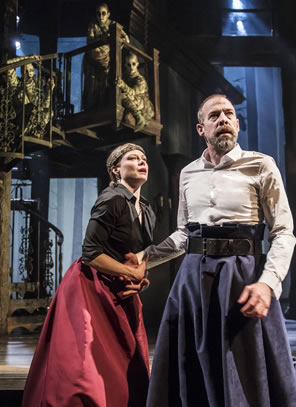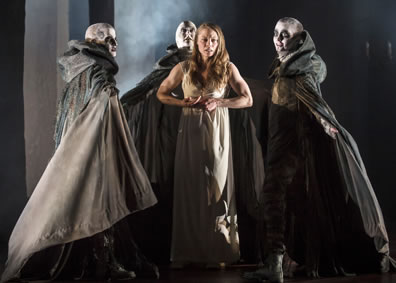Macbeth
The Magic Macbeth Show
Chicago Shakespeare Theater on Navy Pier, The Yard, Chicago, Illinois
Wednesday, May 30, 2018, B–5&16 (floor, front left)
Adapted and directed by Aaron Posner and Teller

Lady Macbeth (Chaon Cross, left) and Macbeth (Ian Merrill Peakes) reach a crossroads as the Weird Sisters watch from above in the Chicago Shakespeare Theater's production of William Shakespeare's Macbeth. Photo by Liz Lauren, Chicago Shakespeare Theater.
A child’s coffin sits in the middle of the stage. A strange discordant soundtrack rises around us. Three red doors on three walls that serve as a backdrop to the set swing open as Lady Macbeth appears on a metal staircase to the left. She descends to the coffin, and three hooded figures glide through the doors. As Lady Macbeth kneels at the coffin, the other three beings pull back their hoods. They may be women, bald with pale, decayed faces, though one has a beard. We now notice that their vocal chords are the source for the soundtrack. These are the Weird Sisters, and they watch intently as Lady Macbeth takes a shrouded infant out of the coffin, hugs it in agony, then returns the corpse to the coffin. She slams shut the lid and stands with a fierce attitude. “When shall we three meet again, in thunder, lightning, or in rain?” the Weird Sisters chant as they raise their sleeves shrouding Lady Macbeth from our view. “Upon the heath, to meet with Macbeth!” and, presto!, Macbeth himself appears from behind the witches’ sleeves where his wife had just been, and he starts engaging in a loud, energetic battle with on-rushing rebel Scots.
And there you have it: horror, action, Shakespeare (for the most part), and magic—real magic in this Chicago Shakespeare Theater production of William Shakespeare’s Macbeth, adapted and directed by Aaron Posner and Teller, the latter one-half of the Las Vegas magic team of Penn and Teller. This opening scene summarizes the why and wherefore of this production: It’s more about the magic, atmosphere, and accessible storytelling than it is about Shakespeare’s text and psychological mystery, but as theatrical entertainment, it’s a thriller.
It’s also a historical production in the annals of Chicago Shakespeare Theater on Navy Pier. The company moved here in 1999 as part of the city’s major rejuvenation of the Pier but quickly outgrew its two theaters, the deep-thrust Courtyard and the studio theater, Upstairs at Chicago Shakespeare. The company finally took over the site of a tent-covered amphitheater next door, keeping the tent but removing the amphitheater and building in its place The Yard, a 100 percent modular theater. It’s as simple a concept as Legos and yet a technological marvel how the three-tiered seating towers have self-contained lighting, sprinkler systems, and digital cabling yet can be easily moved by three stagehands and clipped into place for any imaginable configuration, be it thrust, arena, in-the-round, cabaret, or some shape somebody hasn’t yet conceived. For Macbeth, The Yard is set up as a 700-seat proscenium arch. The theater debuted last October, staging touring productions, a holiday show, and children’s Shakespeare. Macbeth is Chicago Shakespeare Theater’s first subscription series production in its new space.
The Yard was built specifically for this production, not just its configuration but in a generic sense. Chicago Shakespeare Theater produced Posner’s and Teller’s 2015 magic-rich staging of William Shakespeare’s The Tempest in the Courtyard. While that’s a lovely space, it proved problematic in a theatrical sense (magic on a deep-thrust stage) and inadequate in box office measures as the show proved a huge hit and could have played to larger audiences. With The Yard, the directors get their preferred proscenium arch, and the company gets more seats to fill.
On the reputation of The Tempest—not to mention that this is Macbeth with magic—Posner and Teller deliver another hit, drawing an audience demographically and geographically diverse. But, then, they’ve done this play together before. Posner and Teller first staged Macbeth for the Folger Theatre in Washington, D.C., (co-produced by Two River Theater in Red Bank, New Jersey) in 2008, a production recorded for DVD distribution.
This restaging benefits from a more dynamic set designed by Daniel Conway, supplemented by Thom Weaver’s lighting design as discomforting as a SoHo back alley on a moonless night. The costuming by Mara Blumenfeld is similar to the first outing, the men in ancient kilts and ceremonial gowns of muted colors but accessorized with 20th century farmer sweaters, modern vests, leather overcoats and jackets, and big black boots. Lady Macbeth’s outfits progress through a form-fitting black dress, a red cocktail dress with red high heels, and a formal gown before ending with a simple white nightgown for her blood-seeping sleepwalking scene.
One other technical detail bears highlighting here: Andre Pluess’s sound design. With the actors wearing barely visible microphones, the sound mix is perfect. Adding to that sound mix is Ronnie Malley on his perch above the center of the stage. He is identified in the cast list as Hecate, and though he does not speak any of that character’s lines, he achieves witchcraft with an array of percussion that, with the aural contributions of the Weird Sisters, comprises the dynamically haunting soundtrack.
This Chicago production has one key carryover from the original Folger version: Ian Merrill Peakes plays Macbeth. He not only returns to the role 10 years older but is now a father, and he tells me in an interview that he now finds Macbeth much more ambiguous in his life view than the stridently ambitious thane he played as a younger man. This creates an interesting juxtaposition in this performance. As a warrior, he fights with an easy swagger, like a farmer mowing down corn with a scythe, but he’s less certain how to handle a greater foe: himself.
When the Weird Sisters meet him and Banquo (Andrew White) on the heath after the opening battle, the witches kneel upon greeting Macbeth as “king hereafter,” and he kneels along with them, hypnotically staring into their eyes. They not only offer him a glimpse into his potential future but also seem to unveil the Macbeth that could become king shortly hereafter, and he’s frightened by what he sees there. As his wife goads him to murder, Peake’s Macbeth is hesitant to unleash that other self onto himself; but when he does, it totally subsumes him and unleashes that other self onto the world.
Chaon Cross is coming to the role of Lady Macbeth 20 years after playing it the first time at what is now the American Shakespeare Center in Staunton, Virginia. The most significant change for her since that time, she says, is becoming a mother. In a talk-back program with high school students after a matinee, Cross says she instigated the discussion with Posner that led to the new opening scene, pointing out that Shakespeare’s text often references that the Macbeths were onetime parents. Furthermore, children—the Macbeths lacking them while his key enemies have progeny—is a major theme of the play. In that tacked-on beginning, we can see the evolution in Lady Macbeth’s temperament, but it is in Cross’s burning intensity delivering the “unsex me” speech that she gives up her sense of motherhood in order to pour all her emotional and psychological energy into her husband’s success. Cross and Peakes have great chemistry as the Macbeths, sharing that second-nature sense spouses have of each other’s presence and preferences. The two express through their demeanor toward each other a depth within the text that supplements what they express with the text.
Posner maintains many of the same manipulations of Shakespeare’s text and plot structure he applied in his first outing with this play, such as juxtaposing lines for a more cinematic effect. This time, thank goodness, he doesn’t overlay Macbeth’s aside on how he must “o’erleap” the Prince of Cumberland with Lady Macbeth’s letter reading, as he did in the Folger production. However, he still plays out Banquo’s murder at the back of the stage while the Macbeths talk of rooky woods at the front. For soliloquies, all action stops as the soliloquizing character, in spotlight, speaks. After the Weird Sisters greet the two, Banquo does his "instruments of darkness" passage as a soliloquy (rather than speaking it to Macbeth), then, with a bell and light cue, the focus shifts to Macbeth for his “Cannot be ill, cannot be good” soliloquy. Similarly, Posner has Banquo's "Thou hast it" soliloquy at the beginning of Act III, Scene 1, lead directly into Macbeth's "To be thus is nothing" soliloquy from later in that scene.
As with the original production, this staging brings Macduff (Timothy D. Stickney) forward to the opening scene (he’s one of the messengers reporting on the battle); he also is joined by his wife and kids as part of the entourage accompanying King Duncan to Macbeth’s castle. Posner and Teller are playing the family tragedy card here rather than Shakespeare’s more subtle hand in establishing Macduff as Macbeth’s instrument of undoing, aurally arriving with a loud knock at the very moment of Duncan’s murder
Other Posner touches carrying over from the initial production. Malcolm has a powerful presence (this production utilizes a dominating performance by Adam Wesley Brown), the king's eldest son not only grounding the England scene but proving a capable administrator for his father, Duncan (Christopher Donahue as a virile but somewhat doddering king). Posner also allows the Porter (Matthew Floyd Miller) free reign to ad lib as he works his way through the audience to the stage, riffing on knock-knock jokes, equivocation, and individual patrons.

The Weird Sisters (from left, Theo Germaine, McKinley Carter, Emily Ann Nichelson) haunt Lady Macbeth (Chaon Cross) in the Chicago Shakespeare Theater production of Shakespeare's Macbeth. Photo by Liz Lauren, Chicago Shakespeare Theater.
The opening scene of Lady Macbeth with the casket is not the only new interpolation in this remount. A more significant extratextual addition—and one I find theatrically and thematically fascinating and satisfying—is expanding the role of the Weird Sisters. Rather than being limited to three scenes in the text, McKinley Carter, Theo Germaine, and Emily Ann Nichelson and their chilling vocalizations gather either on stage or watch from Hecate’s perch above or beyond the walls at every pivotal moment in the Macbeths’ history, from that pre-Shakespearean opening to a post-Shakespearean finale. They are on stage when Duncan decrees that Cawdor should be put to death and his title given to Macbeth. They listen to both Macbeth’s and Lady Macbeth’s soliloquies. They are there when Macbeth notes that he must "Cumberland o'erleap or must fall down" and when he calls for the murderers. They provide a supernatural host around Lady Macbeth when she wants to be unsexed. They hang out in Dunsinane.
In these scenes, the Weird Sisters don’t seem to be dictating the fates so much as intently observing the unfolding car wreck that the Macbeths become. Did they set the car wreck in motion or did they merely show Macbeth how to drive into it himself? The exception to their noninterference is echoing Macbeth each time he says “sleep no more” and then, later, whispering it to him when he starts to doze off.
Then there’s the doubling, troubling, bubbling cauldron concoction they create, each of the ingredients visibly being dropped into the stew (so that’s what a maw and gulf of a ravin'd salt-sea shark looks like?). One witch snaps the finger off the tiny hand of a “birth-strangled babe,” and as the finger is dropped in the pot, the other witch pockets the rest of the hand. Sick cool. The apparitions emerge out of the pot itself. Ironically, the apparition that is totally excised is that of Banquo’s descendants representing a long line of kings, ending with the mirror trick that scholars believe somehow reflected King James himself when Shakespeare’s play originally played at court. Did the Bard accomplish a trick beyond even Teller’s talent?
That’s hard to believe, for the magic in this production is breathtaking (as in, the congregate sound of spines hitting chairbacks when Banquo’s ghost appears the second time using a great feint-and-switch technique). Tricks include the apparitions, Macbeth grabbing for Banquo’s ghost and choking a lord instead, the murderer snapping the neck of Macduff’s son (some people in the audience appear on the verge of being ill with that one), Macbeth snapping the arm of Siward’s son (more gasps from the audience), and Lady Macbeth spouting blood from nowhere in her sleepwalking scene (she’s wearing a sleeveless white gown). Macbeth’s dagger “which I see before me” but cannot clutch is not a mere figment of Peake’s imagination because we can see it floating in air. The most effective trick—one that I could not figure out despite my knowledge of stage and haunted house trickery—happens on the heath when Macbeth and Banquo grab hold of one of the Weird Sisters and what seemed corporal melts as breath into the wind, leaving them grappling with just the witch's cloak.
In Macbeth’s climactic fight with Macduff, in addition to the Weird Sisters watching (of course), all of the play’s ghosts appear: Banquo, Duncan (emerging out of an empty throne), Macduff's family, and then Lady Macbeth. Cross’s Lady Macbeth bears an expression of peace, as if lovingly ready to welcome her husband to the afterlife. I’m not sure Macbeth goes to the same afterlife as Lady Macbeth, however, as Posner’s and Teller’s play continues after Shakespeare’s ends with one final trick involving the Weird Sisters and the pet they always wanted to have.
Macbeth is a "dangerous show," Teller says in a preshow recording. "If you stick your feet into the aisle, and players stroll down the aisle with swords, you could get stabbed and scarred,” saying this in a disinterestedly pleasing voice (he also requests that, as this is a dark show in a dark theater, we should make our cell phones "as dark as the grave"). He and Posner then take us on a magical, Shakespearean-based ride. That this widely demographic audience rocks The Yard with a roar of applause at the end is no big trick: It’s just good magic—many layers’ worth.
Eric Minton
June 29, 2018
Comment: e-mail editorial@shakespeareances.com
Start a discussion in the Bardroom




 Find additional Shakespeareances
Find additional Shakespeareances